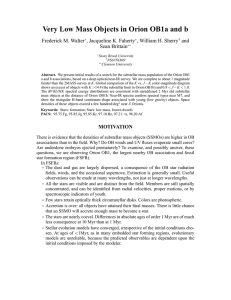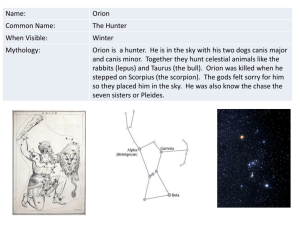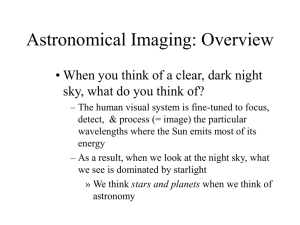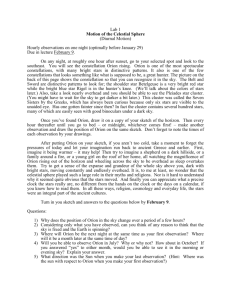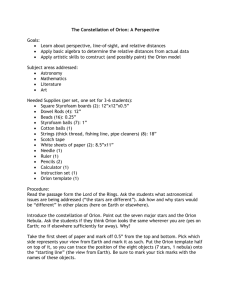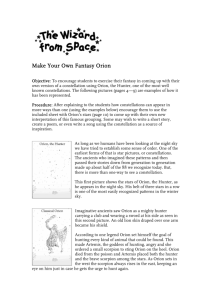Document 11132040
advertisement
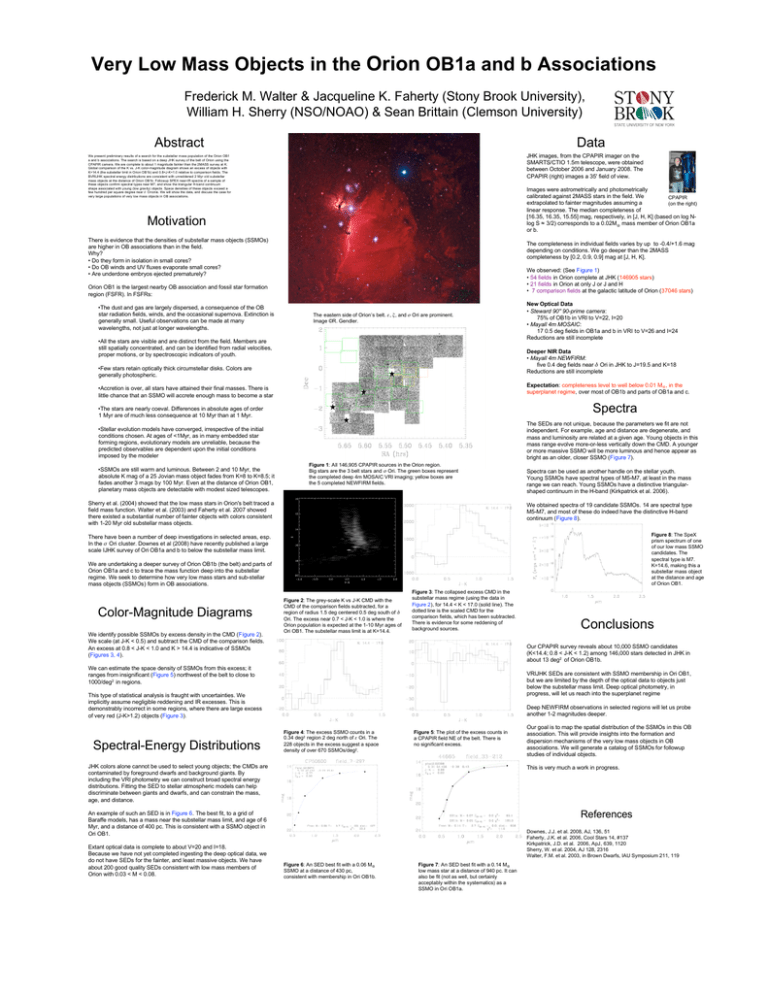
Very Low Mass Objects in the Orion OB1a and b Associations Frederick M. Walter & Jacqueline K. Faherty (Stony Brook University), William H. Sherry (NSO/NOAO) & Sean Brittain (Clemson University) Abstract Data JHK images, from the CPAPIR imager on the SMARTS/CTIO 1.5m telescope, were obtained between October 2006 and January 2008. The CPAPIR (right) images a 35' field of view. We present preliminary results of a search for the substellar mass population of the Orion OB1 a and b associations. The search is based on a deep JHK survey of the belt of Orion using the CPAPIR camera. We are complete to about 1 magnitude fainter than the 2MASS survey at K. Global comparison of the K vs. J-K color-magnitude diagram shows an excess of objects with K>14.4 (the substellar limit in Orion OB1b) and 0.8<J-K<1.0 relative to comparison fields. The BVRIJHK spectral energy distributions are consistent with unreddened 2 Myr old substellar mass objects at the distance of Orion OB1b. Followup SPEX near-IR spectra of a sample of these objects confirm spectral types near M7, and show the triangular H-band continuum shape associated with young (low gravity) objects. Space densities of these objects exceed a few hundred per square degree near O rionis. We will show the data, and discuss the case for very large populations of very low mass objects in OB associations. Images were astrometrically and photometrically calibrated against 2MASS stars in the field. We CPAPIR extrapolated to fainter magnitudes assuming a (on the right) linear response. The median completeness of [16.35, 16.35, 15.55] mag, respectively, in [J, H, K] (based on log Nlog S ≈ 3/2) corresponds to a 0.02M mass member of Orion OB1a or b. Motivation There is evidence that the densities of substellar mass objects (SSMOs) are higher in OB associations than in the field. Why? • Do they form in isolation in small cores? • Do OB winds and UV fluxes evaporate small cores? • Are underdone embryos ejected prematurely? The completeness in individual fields varies by up to -0.4/+1.6 mag depending on conditions. We go deeper than the 2MASS completeness by [0.2, 0.9, 0.9] mag at [J, H, K]. We observed: (See Figure 1) • 54 fields in Orion complete at JHK (146905 stars) • 21 fields in Orion at only J or J and H • 7 comparison fields at the galactic latitude of Orion (37046 stars) Orion OB1 is the largest nearby OB association and fossil star formation region (FSFR). In FSFRs: •The dust and gas are largely dispersed, a consequence of the OB star radiation fields, winds, and the occasional supernova. Extinction is generally small. Useful observations can be made at many wavelengths, not just at longer wavelengths. The eastern side of Orion’s belt. , , and Ori are prominent. Image ©R. Gendler. •All the stars are visible and are distinct from the field. Members are still spatially concentrated, and can be identified from radial velocities, proper motions, or by spectroscopic indicators of youth. Deeper NIR Data • Mayall 4m NEWFIRM: five 0.4 deg fields near Ori in JHK to J=19.5 and K=18 Reductions are still incomplete •Few stars retain optically thick circumstellar disks. Colors are generally photospheric. Expectation: completeness level to well below 0.01 M, in the superplanet regime, over most of OB1b and parts of OB1a and c. •Accretion is over, all stars have attained their final masses. There is little chance that an SSMO will accrete enough mass to become a star Spectra •The stars are nearly coeval. Differences in absolute ages of order 1 Myr are of much less consequence at 10 Myr than at 1 Myr. The SEDs are not unique, because the parameters we fit are not independent. For example, age and distance are degenerate, and mass and luminosity are related at a given age. Young objects in this mass range evolve more-or-less vertically down the CMD. A younger or more massive SSMO will be more luminous and hence appear as bright as an older, closer SSMO (Figure 7). •Stellar evolution models have converged, irrespective of the initial conditions chosen. At ages of <1Myr, as in many embedded star forming regions, evolutionary models are unreliable, because the predicted observables are dependent upon the initial conditions imposed by the modeler •SSMOs are still warm and luminous. Between 2 and 10 Myr, the absolute K mag of a 25 Jovian mass object fades from K=8 to K=8.5; it fades another 3 mags by 100 Myr. Even at the distance of Orion OB1, planetary mass objects are detectable with modest sized telescopes. New Optical Data • Steward 90" 90-prime camera: 75% of OB1b in VRI to V=22, I=20 • Mayall 4m MOSAIC: 17 0.5 deg fields in OB1a and b in VRI to V=26 and I=24 Reductions are still incomplete Figure 1: All 146,905 CPAPIR sources in the Orion region. Big stars are the 3 belt stars and Ori. The green boxes represent the completed deep 4m MOSAIC VRI imaging; yellow boxes are the 5 completed NEWFIRM fields. Sherry et al. (2004) showed that the low mass stars in Orion's belt traced a field mass function. Walter et al. (2003) and Faherty et al. 2007 showed there existed a substantial number of fainter objects with colors consistent with 1-20 Myr old substellar mass objects. Spectra can be used as another handle on the stellar youth. Young SSMOs have spectral types of M5-M7, at least in the mass range we can reach. Young SSMOs have a distinctive triangularshaped continuum in the H-band (Kirkpatrick et al. 2006). We obtained spectra of 19 candidate SSMOs. 14 are spectral type M5-M7, and most of these do indeed have the distinctive H-band continuum (Figure 8). Figure 8: The SpeX prism spectrum of one of our low mass SSMO candidates. The spectral type is M7. K=14.6, making this a substellar mass object at the distance and age of Orion OB1. There have been a number of deep investigations in selected areas, esp. In the Ori cluster. Downes et al (2008) have recently published a large scale IJHK survey of Ori OB1a and b to below the substellar mass limit. We are undertaking a deeper survey of Orion OB1b (the belt) and parts of Orion OB1a and c to trace the mass function deep into the substellar regime. We seek to determine how very low mass stars and sub-stellar mass objects (SSMOs) form in OB associations. Color-Magnitude Diagrams We identify possible SSMOs by excess density in the CMD (Figure 2). We scale (at J-K < 0.5) and subtract the CMD of the comparison fields. An excess at 0.8 < J-K < 1.0 and K > 14.4 is indicative of SSMOs (Figures 3, 4). Figure 2: The grey-scale K vs J-K CMD with the CMD of the comparison fields subtracted, for a region of radius 1.5 deg centered 0.5 deg south of Ori. The excess near 0.7 < J-K < 1.0 is where the Orion population is expected at the 1-10 Myr ages of Ori OB1. The substellar mass limit is at K=14.4. Figure 3: The collapsed excess CMD in the substellar mass regime (using the data in Figure 2), for 14.4 < K < 17.0 (solid line). The dotted line is the scaled CMD for the comparison fields, which has been subtracted. There is evidence for some reddening of background sources. Our CPAPIR survey reveals about 10,000 SSMO candidates (K<14.4; 0.8 < J-K < 1.2) among 146,000 stars detected in JHK in about 13 deg2 of Orion OB1b. We can estimate the space density of SSMOs from this excess; it ranges from insignificant (Figure 5) northwest of the belt to close to 1000/deg2 in regions. VRIJHK SEDs are consistent with SSMO membership in Ori OB1, but we are limited by the depth of the optical data to objects just below the substellar mass limit. Deep optical photometry, in progress, will let us reach into the superplanet regime This type of statistical analysis is fraught with uncertainties. We implicitly assume negligible reddening and IR excesses. This is demonstrably incorrect in some regions, where there are large excess of very red (J-K>1.2) objects (Figure 3) . Spectral-Energy Distributions Deep NEWFIRM observations in selected regions will let us probe another 1-2 magnitudes deeper. Figure 4: The excess SSMO counts in a 0.34 deg2 region 2 deg north of Ori. The 228 objects in the excess suggest a space density of over 670 SSMOs/deg2. Figure 5: The plot of the excess counts in a CPAPIR field NE of the belt. There is no significant excess. JHK colors alone cannot be used to select young objects; the CMDs are contaminated by foreground dwarfs and background giants. By including the VRI photometry we can construct broad spectral energy distributions. Fitting the SED to stellar atmospheric models can help discriminate between giants and dwarfs, and can constrain the mass, age, and distance. Our goal is to map the spatial distribution of the SSMOs in this OB association. This will provide insights into the formation and dispersion mechanisms of the very low mass objects in OB associations. We will generate a catalog of SSMOs for followup studies of individual objects. This is very much a work in progress. References An example of such an SED is in Figure 6. The best fit, to a grid of Baraffe models, has a mass near the substellar mass limit, and age of 6 Myr, and a distance of 400 pc. This is consistent with a SSMO object in Ori OB1. Extant optical data is complete to about V=20 and I=18. Because we have not yet completed ingesting the deep optical data, we do not have SEDs for the fainter, and least massive objects. We have about 200 good quality SEDs consistent with low mass members of Orion with 0.03 < M < 0.08. Conclusions Downes, J.J. et al. 2008, AJ, 136, 51 Faherty, J.K. et al. 2006, Cool Stars 14, #137 Kirkpatrick, J.D. et al. 2006, ApJ, 639, 1120 Sherry, W. et al. 2004, AJ 128, 2316 Walter, F.M. et al. 2003, in Brown Dwarfs, IAU Symposium 211, 119 Figure 6: An SED best fit with a 0.06 M SSMO at a distance of 430 pc, consistent with membership in Ori OB1b. Figure 7: An SED best fit with a 0.14 M low mass star at a distance of 940 pc. It can also be fit (not as well, but certainly acceptably within the systematics) as a SSMO in Ori OB1a.
